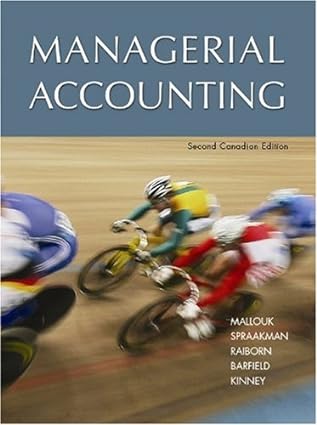Question
1. Total assets turnover measures the ability of a firm to: a. Generate profits on sales b. Generates sales through the use of assets C.
1. Total assets turnover measures the ability of a firm to:
a. Generate profits on sales
b. Generates sales through the use of assets
C. Buy new Assets
D. Move inventory
E. Cover long term debt.
2.Managerial accounting :
a. focuses only on historical data
b. is govern by GAAP
c. focuses primarily on the needs of personnel within the organization.
d. provides information for parties external to the organization
e. focuses on the financial statement and other financial reports.
3. which of the following statement about similarities between process costing and job costing are true.
I. Both systems assign production costs to unit of output.
II. Both system require extensive knowledge of financial accounting.
III. The flow of costs through the manaufacturing accopunts is essentially the same.
A. I only
B. I and III
C. II and III
D. III only
E. I,II, and III
4. The comprehensive set of budget that serves as a company overall financial plan si commonly known as:
A. Integrated budget
B. a Pro-forma budget
C. Master budget
D. a master budget
E. a rolling budget
5. A flexible budget:
A. classifies budget request by activity and estimates the benefits arising from each activity.
B. presents a statement of expectations for a period of time but does not present a firm committment.
C. presents the plan for only one level of activity and does not adjust to changes in the level of activity.
D presents the plan for a range of activity so that the plan can be adjust for changes in the activity level.
6. Which of the following is the correct method to calculate a predetermined overhead rate?
A. Budgeted total manufacturing cost budgeted amount of cost driver.
B. Budgeted overhead cost budgeted amount of cost driver
C. Budgeted amount of cost driver budgeted overhead cost
D. Actual overhead cost budgeted amount of cost driver
E. Actual overhead cost actual amount of cost driver.
7.Which of the following statements about joint-cost allocation is FALSE?
A. Joint cost allocation is useful in deciding whether to further process a product after split-off
B. Joint cost allocation is useful in making a profit determination about individual joint products
C. Joint cost allocation is helpful in inventory valuation
D. Joint cost allocation can be based on the number of units produced.
E. Joint cost allocation can be accompanied by using different methods that focus on sale value and product worth.
8.The total production cost of a job is composed of:
A. Direct material and direct labor
B. direct material, direct labor, manufacturing overhead, and outlays for selling costs.
C. direct material. direct labor, manufacturing overhead,and outlays for both selling and administration costs.
D. direct materiaL, direct labor,and applied manufacturing overhead
E. direct material, direct labor, and selling expenses.
9.What will cause the variable overhead efficiency variance?
A. Efficient or inefficient use of a specific component of variable overhead(e.g. electricity)
B. Full or partial utilization of major equipment resources
C. Production of unit in excess of the number of units sold.
D. Efficient or inefficient use of cost driver(e.g. machine hours) for variable overhead
E. Changes in the salary cost of manufacturing supervisors.
10. Which of the following is classified as an inventory shortage cost?
A. Purchase order preparation
B. Production disruption
C. Lost sales and lost customers.
D. Spoilage
E. Production disruption, lost sales and lost customers.
Step by Step Solution
There are 3 Steps involved in it
Step: 1

Get Instant Access to Expert-Tailored Solutions
See step-by-step solutions with expert insights and AI powered tools for academic success
Step: 2

Step: 3

Ace Your Homework with AI
Get the answers you need in no time with our AI-driven, step-by-step assistance
Get Started


